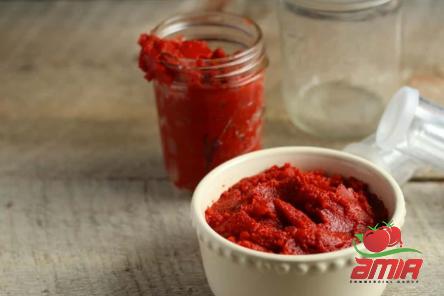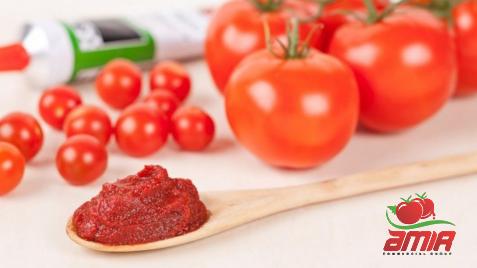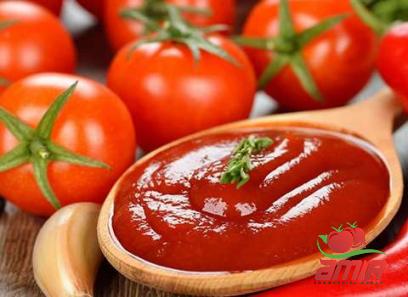Tomato paste is a versatile ingredient that adds depth, richness, and complexity to a wide range of dishes. Whether you’re making a classic Italian marinara sauce, a flavorful curry, or a hearty stew, the right tomato paste can elevate your cooking to new heights. In this comprehensive guide, we’ll delve into the world of good tomato paste, exploring its uses, varieties, benefits, and how to choose the best one for your culinary needs. Benefits of Using Tomato Paste: Tomato paste is a concentrated form of tomatoes that offers a myriad of benefits in the kitchen. One of the main advantages of using tomato paste is its rich umami flavor, which can enhance the taste of dishes without overpowering other ingredients. Additionally, tomato paste is packed with nutrients like lycopene, a powerful antioxidant known for its potential health benefits, including reducing the risk of certain chronic diseases. Different Varieties of Tomato Paste: When it comes to tomato paste, not all products are created equal. There are various varieties of tomato paste available in the market, each with its unique flavor profile and consistency.

.
 The most common types of tomato paste include: 1. Regular Tomato Paste: This type of tomato paste is made from ripe tomatoes that have been cooked down, strained, and reduced to a thick, smooth consistency. It has a balanced flavor profile and is suitable for a wide range of dishes. 2. Double Concentrated Tomato Paste: Double concentrated tomato paste is made by cooking tomatoes for a longer period, resulting in a thicker and more intense flavor. It is ideal for dishes that require a bold tomato taste. 3. Organic Tomato Paste: Organic tomato paste is made from organically grown tomatoes, free from synthetic pesticides and fertilizers. It offers a more natural flavor and is a great choice for health-conscious consumers. 4. Sun-dried Tomato Paste: Sun-dried tomato paste is made from tomatoes that have been naturally dried in the sun, intensifying their sweetness and umami flavor. It adds a unique depth to dishes like pasta sauces and dips. How to Choose Good Tomato Paste: With so many options available, choosing the right tomato paste can be overwhelming. Here are some key factors to consider when selecting a good tomato paste for your cooking needs: 1. Quality of Tomatoes: Look for tomato paste made from ripe, high-quality tomatoes for the best flavor and nutritional content. 2. Consistency: Consider the consistency of the tomato paste – whether you prefer a smooth, thick paste or a more chunky texture.
The most common types of tomato paste include: 1. Regular Tomato Paste: This type of tomato paste is made from ripe tomatoes that have been cooked down, strained, and reduced to a thick, smooth consistency. It has a balanced flavor profile and is suitable for a wide range of dishes. 2. Double Concentrated Tomato Paste: Double concentrated tomato paste is made by cooking tomatoes for a longer period, resulting in a thicker and more intense flavor. It is ideal for dishes that require a bold tomato taste. 3. Organic Tomato Paste: Organic tomato paste is made from organically grown tomatoes, free from synthetic pesticides and fertilizers. It offers a more natural flavor and is a great choice for health-conscious consumers. 4. Sun-dried Tomato Paste: Sun-dried tomato paste is made from tomatoes that have been naturally dried in the sun, intensifying their sweetness and umami flavor. It adds a unique depth to dishes like pasta sauces and dips. How to Choose Good Tomato Paste: With so many options available, choosing the right tomato paste can be overwhelming. Here are some key factors to consider when selecting a good tomato paste for your cooking needs: 1. Quality of Tomatoes: Look for tomato paste made from ripe, high-quality tomatoes for the best flavor and nutritional content. 2. Consistency: Consider the consistency of the tomato paste – whether you prefer a smooth, thick paste or a more chunky texture.
..
 3. Ingredients: Read the label carefully and choose tomato paste with minimal added ingredients and no preservatives or artificial flavors. 4. Packaging: Opt for tomato paste packaged in a tube or aseptic box rather than a can, as it preserves the flavor and freshness better. 5. Brand Reputation: Choose reputable brands known for their quality tomato products to ensure you’re getting a good tomato paste. Tips for Using Tomato Paste in Cooking: Once you’ve selected the perfect tomato paste for your needs, here are some tips for making the most of this versatile ingredient in your cooking: 1. Use it as a Base: Tomato paste serves as an excellent base for sauces, stews, soups, and marinades, providing depth of flavor and richness. 2. Dilute with Liquid: When using tomato paste in a recipe, dilute it with water, broth, or wine to achieve the desired consistency and balance of flavors. 3. Cook it Out: To develop the full flavor of tomato paste, cook it in oil or butter before adding other ingredients to the dish. 4. Add at the Right Time: Incorporate tomato paste early in the cooking process to allow its flavors to meld with other ingredients and enhance the overall dish. Storage and Shelf Life of Tomato Paste: To ensure the longevity and freshness of your tomato paste, store it properly in a cool, dark place away from direct sunlight and heat. Once opened, transfer any remaining tomato paste to an airtight container and refrigerate it for up to a week. Alternatively, freeze leftover tomato paste in ice cube trays for longer storage. In conclusion, good tomato paste is a pantry staple that can transform ordinary dishes into extraordinary culinary masterpieces. By understanding the different varieties, selecting the right product, and mastering its uses in cooking, you can unlock the full potential of tomato paste in your kitchen. So next time you’re planning a meal, reach for a quality tomato paste and let its rich flavor and versatility shine through in your dishes.
3. Ingredients: Read the label carefully and choose tomato paste with minimal added ingredients and no preservatives or artificial flavors. 4. Packaging: Opt for tomato paste packaged in a tube or aseptic box rather than a can, as it preserves the flavor and freshness better. 5. Brand Reputation: Choose reputable brands known for their quality tomato products to ensure you’re getting a good tomato paste. Tips for Using Tomato Paste in Cooking: Once you’ve selected the perfect tomato paste for your needs, here are some tips for making the most of this versatile ingredient in your cooking: 1. Use it as a Base: Tomato paste serves as an excellent base for sauces, stews, soups, and marinades, providing depth of flavor and richness. 2. Dilute with Liquid: When using tomato paste in a recipe, dilute it with water, broth, or wine to achieve the desired consistency and balance of flavors. 3. Cook it Out: To develop the full flavor of tomato paste, cook it in oil or butter before adding other ingredients to the dish. 4. Add at the Right Time: Incorporate tomato paste early in the cooking process to allow its flavors to meld with other ingredients and enhance the overall dish. Storage and Shelf Life of Tomato Paste: To ensure the longevity and freshness of your tomato paste, store it properly in a cool, dark place away from direct sunlight and heat. Once opened, transfer any remaining tomato paste to an airtight container and refrigerate it for up to a week. Alternatively, freeze leftover tomato paste in ice cube trays for longer storage. In conclusion, good tomato paste is a pantry staple that can transform ordinary dishes into extraordinary culinary masterpieces. By understanding the different varieties, selecting the right product, and mastering its uses in cooking, you can unlock the full potential of tomato paste in your kitchen. So next time you’re planning a meal, reach for a quality tomato paste and let its rich flavor and versatility shine through in your dishes.
…
 Further Tips and Recipes Using Tomato Paste: 1. Flavor Boost: Tomato paste can be used to enhance the flavor of a variety of dishes beyond traditional tomato-based recipes. Add a spoonful to chili, meatloaf, or even a stir-fry for an extra depth of flavor. 2. Pizza Sauce: Create a quick and delicious pizza sauce by mixing tomato paste with olive oil, garlic, and Italian seasoning. Spread it on your pizza dough before adding toppings for a rich and savory base. 3. Creamy Tomato Soup: Make a comforting creamy tomato soup by combining tomato paste with broth, cream, and seasonings. Simmer until thick and creamy for a satisfying bowl of soup. 4. Bolognese Sauce: Elevate your pasta dishes with a hearty Bolognese sauce made with tomato paste, ground meat, aromatics, and herbs. Let it simmer slowly to develop rich flavors. 5. Shakshuka: Prepare a flavorful Middle Eastern dish called Shakshuka by simmering eggs in a spiced tomato sauce made with tomato paste, bell peppers, onions, and spices. Serve with crusty bread for a hearty meal. 6. Moroccan Tagine: Create a fragrant Moroccan tagine by combining tomato paste with a blend of warm spices, vegetables, and protein of your choice. Let it simmer slowly for a dish bursting with exotic flavors. Recipes for Homemade Tomato Paste: If you’re feeling adventurous or want to experience the satisfaction of making your own tomato paste from scratch, here are two simple recipes to try: 1. Oven-Roasted Tomato Paste: – Preheat your oven to 300°F (150°C). – Halve tomatoes and place them on a baking sheet lined with parchment paper. – Drizzle with olive oil, sprinkle with salt, and roast for 3-4 hours until the tomatoes are soft and caramelized. – Remove the tomatoes from the oven and let them cool. – Blend the roasted tomatoes until smooth, then simmer in a saucepan until thickened to your desired consistency. – Store in an airtight container in the refrigerator for up to a week or freeze for longer storage. 2. Stovetop Tomato Paste: – Chop tomatoes and cook them in a saucepan over medium heat until they release their juices. – Simmer for 1-2 hours, stirring occasionally, until the tomatoes break down and thicken. – Blend the cooked tomatoes until smooth, then strain through a fine sieve to remove seeds and skins. – Return the strained mixture to the saucepan and continue to simmer until thickened like paste. – Transfer to jars, cool, and store in the refrigerator or freezer. In conclusion, good tomato paste is a culinary powerhouse that adds depth, richness, and complexity to a wide range of dishes. By understanding the different varieties, selecting high-quality products, exploring creative uses in cooking, and even making your own homemade version, you can elevate your culinary creations to new heights. So, next time you’re in the kitchen, don’t underestimate the impact of a good tomato paste and unleash its full potential in your dishes.
Further Tips and Recipes Using Tomato Paste: 1. Flavor Boost: Tomato paste can be used to enhance the flavor of a variety of dishes beyond traditional tomato-based recipes. Add a spoonful to chili, meatloaf, or even a stir-fry for an extra depth of flavor. 2. Pizza Sauce: Create a quick and delicious pizza sauce by mixing tomato paste with olive oil, garlic, and Italian seasoning. Spread it on your pizza dough before adding toppings for a rich and savory base. 3. Creamy Tomato Soup: Make a comforting creamy tomato soup by combining tomato paste with broth, cream, and seasonings. Simmer until thick and creamy for a satisfying bowl of soup. 4. Bolognese Sauce: Elevate your pasta dishes with a hearty Bolognese sauce made with tomato paste, ground meat, aromatics, and herbs. Let it simmer slowly to develop rich flavors. 5. Shakshuka: Prepare a flavorful Middle Eastern dish called Shakshuka by simmering eggs in a spiced tomato sauce made with tomato paste, bell peppers, onions, and spices. Serve with crusty bread for a hearty meal. 6. Moroccan Tagine: Create a fragrant Moroccan tagine by combining tomato paste with a blend of warm spices, vegetables, and protein of your choice. Let it simmer slowly for a dish bursting with exotic flavors. Recipes for Homemade Tomato Paste: If you’re feeling adventurous or want to experience the satisfaction of making your own tomato paste from scratch, here are two simple recipes to try: 1. Oven-Roasted Tomato Paste: – Preheat your oven to 300°F (150°C). – Halve tomatoes and place them on a baking sheet lined with parchment paper. – Drizzle with olive oil, sprinkle with salt, and roast for 3-4 hours until the tomatoes are soft and caramelized. – Remove the tomatoes from the oven and let them cool. – Blend the roasted tomatoes until smooth, then simmer in a saucepan until thickened to your desired consistency. – Store in an airtight container in the refrigerator for up to a week or freeze for longer storage. 2. Stovetop Tomato Paste: – Chop tomatoes and cook them in a saucepan over medium heat until they release their juices. – Simmer for 1-2 hours, stirring occasionally, until the tomatoes break down and thicken. – Blend the cooked tomatoes until smooth, then strain through a fine sieve to remove seeds and skins. – Return the strained mixture to the saucepan and continue to simmer until thickened like paste. – Transfer to jars, cool, and store in the refrigerator or freezer. In conclusion, good tomato paste is a culinary powerhouse that adds depth, richness, and complexity to a wide range of dishes. By understanding the different varieties, selecting high-quality products, exploring creative uses in cooking, and even making your own homemade version, you can elevate your culinary creations to new heights. So, next time you’re in the kitchen, don’t underestimate the impact of a good tomato paste and unleash its full potential in your dishes.










Your comment submitted.